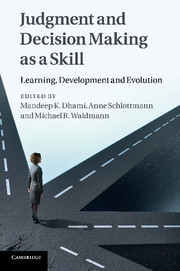Book contents
- Frontmatter
- Contents
- Figures
- Contributors
- Preface
- Acknowledgments
- Chapter cross-reference table
- Part I Evolutionary and neural bases of JDM
- Part II Developmental approaches to JDM
- 3 Judgment and decision making in young children
- 4 Judgment and decision making in adolescents
- 5 Aging and decision skills
- Part III Learning JDM
- Part IV Improving and aiding JDM
- Conclusion
- Index
- References
3 - Judgment and decision making in young children
Published online by Cambridge University Press: 05 December 2011
- Frontmatter
- Contents
- Figures
- Contributors
- Preface
- Acknowledgments
- Chapter cross-reference table
- Part I Evolutionary and neural bases of JDM
- Part II Developmental approaches to JDM
- 3 Judgment and decision making in young children
- 4 Judgment and decision making in adolescents
- 5 Aging and decision skills
- Part III Learning JDM
- Part IV Improving and aiding JDM
- Conclusion
- Index
- References
Summary
Introduction
Understanding probability and utility is core to judgment and decision making (JDM). Under a Piagetian view these are formal operational concepts, achieved in adolescence. Most developmental work on JDM indeed involves adolescents (Bruine de Bruin, this volume; Jacobs and Klaczynski, 2002a). The Piagetian approach also fits with a view of JDM as a skill: if we take adults as somewhat under-skilled, then one reason might be lack of practice, prevented during childhood by lack of basic cognitive abilities (Furby and Beyth-Marom, 1992). Thus, when a child contemplates a run for the forbidden sweetie jar, on the standard view, rational considerations of the probabilities of success versus discovery and the utilities of a sweet snack versus parental dismay are not possible.
A standard Piagetian approach has, however, been largely abandoned in cognitive development research, with substantially earlier abilities than predicted by Piaget apparent in practically all cognitive domains, and we will not defend it here. Instead, we review a growing body of research, mostly carried out since earlier reviews (Hoemann and Ross, 1982; Reyna and Brainerd, 1994), showing quite the opposite: that children even before entering school have functional probability understanding. Thus, adults’ lack of skill cannot be blamed on delayed conceptual development. Instead, reasons might lie in the complexity, structure, and meta-cognitive demands of prototypical JDM tasks used with adults and adolescents.
- Type
- Chapter
- Information
- Judgment and Decision Making as a SkillLearning, Development and Evolution, pp. 55 - 84Publisher: Cambridge University PressPrint publication year: 2011
References
- 20
- Cited by



